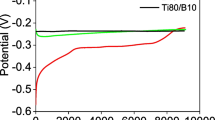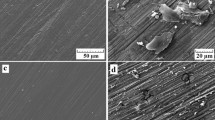Abstract
Through marine natural environment tests, the corrosion behavior of T2 and B30 Cu-Ni alloy at different seawater depths of the South China Sea was studied. The corrosion morphology and corrosion product properties were investigated using different techniques, including 3D optical microscope, scanning electron microscope (SEM), x-ray diffraction analyzer (XRD) and electrochemical impedance spectroscopy (EIS). Based on the environmental factor monitoring data and corrosion rate data, environmental factor influence mechanism on corrosion behavior was discussed The results indicated that the corrosion rate of T2 decreased with seawater depths increasing, while it was opposite for that of B30 Cu-Ni alloy. The evolution law of the corrosion rates of T2 at different seawater depths was mainly controlled by changes in seawater temperature and dissolved oxygen concentration. The effect of hydrostatic pressure was limited on T2 corrosion rate, but high hydrostatic pressure could promote Cl− penetrating into the corrosion product film, forming a uniform corrosion morphology for T2. For B30 Cu-Ni alloy, it was simultaneously affected by dissolved oxygen concentration and hydrostatic pressure, and the corrosion product film was rich in Ni and Fe elements.













Similar content being viewed by others
References
A. Drach, I. Tsukrov, J. DeCew, J. Aufrecht, A. Grohbauer and U. Hofmann, Field Studies of Corrosion Behaviour of Copper Alloys in Natural Seawater, Corros. Sci., 2013, 76, p 453–464.
N. Aelenei, M. Lungu, D. Mareci and N. Cimpoesu, HSLA Steel and Cast Iron Corrosion in Natural Seawater, Environ. Eng. Manag. J., 2011, 10, p 1951–1958.
Z. Cui, X. Li, H. Zhang, K. Xiao, C. Dong, Z. Liu and L. Wang, Atmospheric Corrosion Behavior of 2A12 Aluminum Alloy in a Tropical Marine Environment, Adv. Mater. Sci. Eng., 2015, 2015, p 1–17.
M. Schumacher, Seawater Corrosion Handbook, Noyes Data Corp, Park Ridge, 1979.
B.A. Warren, The Deep Water of the Central Indian Basin, J. Mar. Res., 1982, 40, p 823–859.
R. Venkatesan, M.A. Venkatasamy, T.A. Bhaskaran, E.S. Dwarakadasa and M. Ravindran, Corrosion of Ferrous Alloys in Deep Sea Environments, Br. Corros. J., 2002, 37, p 257–266.
K. Ding, W. Guo, R. Qiu, J. Hou, L. Fan and L. Xu, Corrosion behavior of Q235 Steel Exposed in Deepwater of South China Sea, J. Mater. Eng. Perform., 2018, 27, p 4489–4496.
L. Lin, S. Liu, Z. Liu and J. Xu, Surface and Interface Characteristics of Cu-Ni Alloy Corrosion in Seawater, Corros. Sci. Prot. Technol., 1999, 11, p 37–43.
Y. Yang, T. Zhang, Y. Shao, G. Meng and F. Wang, Effect of Hydrostatic Pressure on the Corrosion Behaviour of Ni-Cr-Mo-V High Strength Steel, Corros. Sci., 2010, 52, p 2697–2706.
A.H. Tuthill, Guidelines for the Use of Copper Alloys in Seawater, Mater. Perform., 1987, 26, p 12–22.
Z. Cui, K. Xiao, C. Dong, Y. Ding, T. Wang and X. Li, Corrosion Behavior of Copper and Brass in Serious Xisha Marine Atmosphere, Trans. Nonferr. Metal. Soc., 2013, 23, p 742–749.
X. Liao, F. Cao, L. Zheng, W. Liu, A. Chen, J. Zhang and C. Cao, Corrosion Behaviour of Copper under Chloride-Containing Thin Electrolyte Layer, Corros. Sci., 2011, 53, p 3289–3298.
R.F. North and M.J. Pryor, The Nature of Protective Film Formed on a Copper Iron Alloy, Corros. Sci., 1969, 9, p 509–516.
D. Kong, C. Dong, X. Ni, L. Zhang, J. Yao, C. Man, X. Cheng, K. Xiao and X. Li, Mechanical Properties and Corrosion Behavior of Selective Laser Melted 316L Stainless Steel after Different Heat Treatment Processes, J. Mater. Sci. Technol., 2019, 35, p 1499–1507.
I.M. Klotz, Introduction to Chemical Thermodynamics, W. A. Benjamin, New York, 1964.
R. Hu, X. Zhao, Y. Weng and C. Lin, Effect of Dissolved Oxygen on the Corrosion Behavior of Coalesced Copper and Stainless Steel-206 in Acetic Solutions, Electrochem., 2002, 8, p 409–414.
R. Davar, The Effects of Temperature, Dissolved Oxygen and the Velocity of Seawater, on the Corrosion Behavior of Condenser Alloys, Anti-Corros. Method. M., 2011, 58, p 90–94.
B. Liu, Y. Cong, T. Zhang, Y. Shao, G. Meng and F. Wang, Influence of Deep-Sea Environment on Corrosion Behavior of Pure Nickel, Corros. Sci. Prot. Technol., 2009, 21, p 5–10.
A.M. Beccaria, G. Poggi and G. Castello, Influence of Passive Film Composition and Sea Water Pressure on Resistance to Localised Corrosion of Some Stainless Steels in Sea Water, Br. Corros. J., 1995, 30, p 283–287.
E.D. Mor and A.M. Beccaria, Effects of Hydrostatic Pressure on the Corrosion of Copper in Sea Water, Br. Corros. J., 2013, 13, p 142–146.
L. Lin, S. Liu and X. Zhu, Seawater-Corrosion-Induced Intergranular Precipitation in Cu-Ni Alloy, J. Chin. Soc. Corros. Prot., 1997, 17, p 1–6.
D. Kong, C. Dong, X. Ni, L. Zhang, H. Luo, R. Li, L. Wang, C. Man and X. Li, The Passivity of Selective Laser Melted 316L Stainless Steel, Appl. Surf. Sci., 2020, 504, p 144495.
T. Liu, H. Chen, W. Zhang and W. Lou, Accelerated Corrosion Behavior of B10 Cu-Ni Alloy in Seawater, J. Mater. Eng., 2017, 45, p 31–37.
H.V.M. Lopez, T. Sakurai, K. Hirano and N. Sano, A Study of Phase Decomposition in Cu-Ni-Fe Alloys, Acta Metal. Mater., 1993, 41, p 265–271.
L.H. Bennett and L.J. Swartzendruber, On the Interpretation of Mössbauer Effect Spectra as Related to the Constitution of Cu-Ni-Fe Alloys, Acta Metall., 1970, 18, p 485–498.
A.M. Beccaria and J. Crousier, Influence of Iron Addition on Corrosion Layer Built up on 70Cu-30Ni Alloy in Sea Water, Br. Corros. J., 1991, 26, p 215–219.
Acknowledgments
This work was finically supported by the National Natural Science Foundation of China (No. 51931008).
Author information
Authors and Affiliations
Corresponding authors
Additional information
Publisher's Note
Springer Nature remains neutral with regard to jurisdictional claims in published maps and institutional affiliations.
Rights and permissions
About this article
Cite this article
Ding, K., Liu, S., Cheng, W. et al. Corrosion Behavior of T2 and B30 Cu-Ni Alloy at Different Seawater Depths of the South China Sea. J. of Materi Eng and Perform 30, 6027–6038 (2021). https://doi.org/10.1007/s11665-021-05790-5
Received:
Revised:
Accepted:
Published:
Issue Date:
DOI: https://doi.org/10.1007/s11665-021-05790-5




